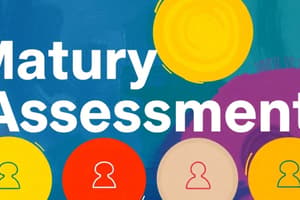Podcast
Questions and Answers
What do cleaning schedules primarily contain information about?
What do cleaning schedules primarily contain information about?
- Staff training programs
- Daily, weekly, and annual cleaning procedures (correct)
- Inventory management and supply ordering
- Annual budget estimates
Which cleaning frequency involves high-level cleaning tasks?
Which cleaning frequency involves high-level cleaning tasks?
- Daily cleaning
- Quarterly cleaning
- Monthly cleaning
- Weekly cleaning (correct)
What is a key focus of annual cleaning procedures?
What is a key focus of annual cleaning procedures?
- Deep cleaning tasks (correct)
- Spot cleaning
- Surface dusting
- Window washing
What aspect of cleanliness standards is included in maintenance procedures?
What aspect of cleanliness standards is included in maintenance procedures?
How often are the cleaning schedules adhered to?
How often are the cleaning schedules adhered to?
Which of the following is NOT typically included in cleaning schedules?
Which of the following is NOT typically included in cleaning schedules?
Which components are typically included in back-office maintenance?
Which components are typically included in back-office maintenance?
What is the primary goal of adhering to cleaning schedules?
What is the primary goal of adhering to cleaning schedules?
Which practice promotes cleanliness and organization among employees?
Which practice promotes cleanliness and organization among employees?
What is the primary goal of a maturity assessment?
What is the primary goal of a maturity assessment?
How frequently should an internal maturity assessment ideally be conducted?
How frequently should an internal maturity assessment ideally be conducted?
Which approach is NOT part of a routine equipment condition assessment?
Which approach is NOT part of a routine equipment condition assessment?
What is a crucial aspect of maintaining cleanliness standards in a workplace?
What is a crucial aspect of maintaining cleanliness standards in a workplace?
Which of the following tasks is related to scheduled maintenance?
Which of the following tasks is related to scheduled maintenance?
What is an expected outcome when using the results of a maturity assessment externally?
What is an expected outcome when using the results of a maturity assessment externally?
Which statement best describes effective maintenance procedures?
Which statement best describes effective maintenance procedures?
What is the maximum distance outside of assigned areas that cleanliness must be maintained?
What is the maximum distance outside of assigned areas that cleanliness must be maintained?
What is included in the maintenance schedule for painting?
What is included in the maintenance schedule for painting?
Which of the following is NOT a standard for equipment condition assessment?
Which of the following is NOT a standard for equipment condition assessment?
What condition should machines and equipment be maintained in according to the standards?
What condition should machines and equipment be maintained in according to the standards?
When is the scheduled maintenance for painting floors and walls supposed to occur?
When is the scheduled maintenance for painting floors and walls supposed to occur?
Which element is emphasized to ensure safety and cleanliness in the environment?
Which element is emphasized to ensure safety and cleanliness in the environment?
In terms of maintenance procedures, which of the following is a key aspect mentioned?
In terms of maintenance procedures, which of the following is a key aspect mentioned?
What should be done if excessive chipping of paint is observed?
What should be done if excessive chipping of paint is observed?
Flashcards
Back-office process
Back-office process
Includes storage rooms, archives, and other back-office areas.
Cleaning schedules
Cleaning schedules
Detailed cleaning plans for daily, weekly, and annual cleaning procedures.
Daily cleaning
Daily cleaning
A 'clean as you go' cleaning style.
Weekly cleaning
Weekly cleaning
Signup and view all the flashcards
Annual cleaning
Annual cleaning
Signup and view all the flashcards
Cleaning schedules contain
Cleaning schedules contain
Signup and view all the flashcards
Storage rooms, archives
Storage rooms, archives
Signup and view all the flashcards
Adhering to schedules
Adhering to schedules
Signup and view all the flashcards
Cleanliness Standard
Cleanliness Standard
Signup and view all the flashcards
Maintenance Schedule
Maintenance Schedule
Signup and view all the flashcards
Paint Condition
Paint Condition
Signup and view all the flashcards
Facility Condition
Facility Condition
Signup and view all the flashcards
Maturity Assessment Purpose
Maturity Assessment Purpose
Signup and view all the flashcards
Internal Maturity Assessment Frequency
Internal Maturity Assessment Frequency
Signup and view all the flashcards
How to Use Maturity Assessment Results (Internal)
How to Use Maturity Assessment Results (Internal)
Signup and view all the flashcards
How to Use Maturity Assessment Results (External)
How to Use Maturity Assessment Results (External)
Signup and view all the flashcards
Continuous Improvement Register
Continuous Improvement Register
Signup and view all the flashcards
'Clean as You Go' Cleaning
'Clean as You Go' Cleaning
Signup and view all the flashcards
Cleaning Habit for Employees
Cleaning Habit for Employees
Signup and view all the flashcards
Why Cleaning and Organising Matters
Why Cleaning and Organising Matters
Signup and view all the flashcards
Study Notes
Maturity Assessment
- A maturity assessment evaluates a company's performance against best practice, using five levels.
- This assessment is used to measure improvement and development.
Maturity Levels
- Novice: Companies at this level are characterized by a traditional, reactive approach.
- They have many unnecessary items in the workplace.
- Notice boards may contain outdated or useless information.
- Cables and items are not stored or placed appropriately, leading to safety hazards.
- Employees use phrases like "We have no time for this" or "This is the way it has always been done".
- Learning: This stage shows initial improvement efforts, often focused on a single area or through unrelated initiatives.
- Teams begin to dispose of unneeded items.
- Horizontal surfaces are cleared of clutter.
- Needed items are organized.
- Phrases like "We have never thought about it this way" are common.
- Competent: This stage signifies a company starting to understand and adopt world-class principles.
- The workplace is becoming more organized, with habits changing.
- Horizontal and vertical items are cleared.
- Notices are up-to-date and relevant.
- Responsibilities and competing teams are promoted.
- Storage spaces are organized.
- Sophisticated: High level of visual management of the workplace, with a performance-driven approach.
- Model workplaces are created.
- Workplaces are efficiently organized based on usage and labeled appropriately.
- Items are color-coded for easier identification.
- World-Class: Companies at this level are flexible, reliable, innovative, and competitive, adapting to changing conditions.
- Workplaces are clean and efficiently organized.
- Items are easily accessible, within one minute in a paper environment and ten seconds in a computer environment.
- All areas of the workplace pass regular inspections.
- Companies hold regular inspections and prioritize keeping the workplace clean.
- Unnecessary filing is reduced, and all items are properly stored or disposed of.
Studying That Suits You
Use AI to generate personalized quizzes and flashcards to suit your learning preferences.



